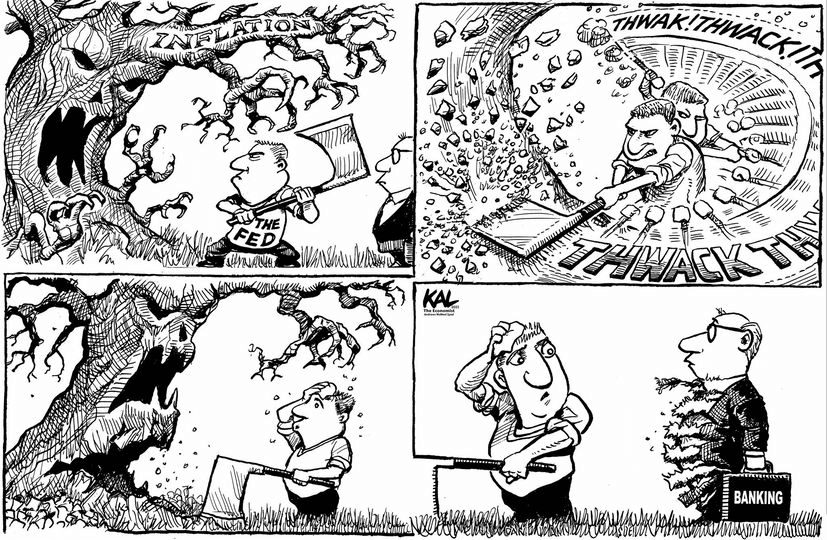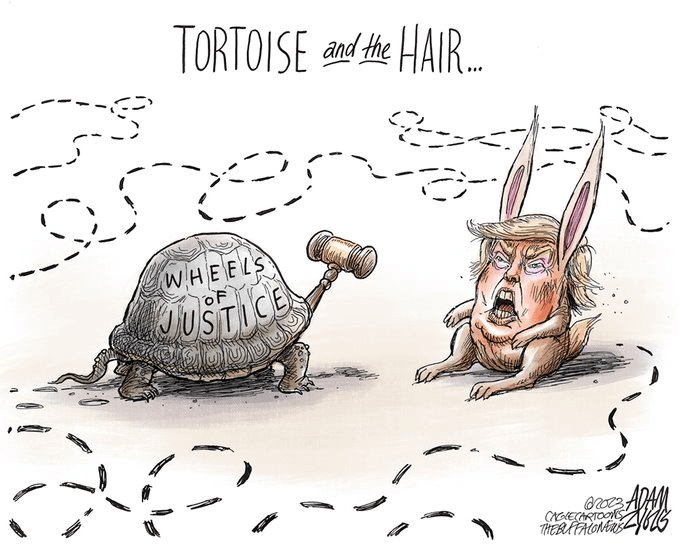CSotD: Of Banks and Busts and Sealing Whacks
Skip to commentsI suppose it shouldn’t be surprising that Kal Kallaugher, who cartoons for the Economist among other clients, should demonstrate some financial literacy and get the SVB/Signature situation right.
Call me political, but the people who whined while the Fed was raising interest rates to battle inflation weren’t offering an alternative plan. You can’t have an argument if the other side hasn’t taken a position.
What Kal gets right is that, while the banker gets tattered, it’s not as if he’s been decapitated or even badly wounded. The rising rates were a significant challenge, but in a well-ordered system, the banks would rise to that challenge, and, after all, it’s been a year since the Fed began gradually raising rates.
A major part of the problem, at least at SVB, was that the loosening of Dodd-Frank regulations meant they didn’t have to perform a regular analysis of their standing, which might have caught the problems.
At this point, whether they were deliberately pushing the envelope or just sloppy is irrelevant.
Meanwhile, the opposition to raising rates is like a kid refusing to eat his vegetables. I understand you don’t like them, but they’re full of vitamins and minerals you won’t get from chicken nuggets and instant mac and cheese.

Kirk Walters (KFS) is usually conservative, but he nearly offers a socialist take on the situation: The banks, as a whole, are okay. It’s the speculators who are freaking out, and the actual stability of the banks is secondary to the impact on stock prices.
It’s important to recognize, as he does here, that stock prices are not necessarily tied into actual performance. They’re based on “analysis” that often comes down to best-guesses.
Kal explained it all in one of his most famous cartoons, which appeared on the cover of the Economist and turned into a little cottage industry for him.
You have to be careful in explaining the relationship between stock prices and actual value. As entertaining an example of irrational exuberance as the 17th Century phenomenon of Tulipomania is for teaching the lesson, it’s a bit dampened by never having happened. (Sorry)
But the fact remains that, when reporters say the stock market rose because of such-and-such, they’re largely guessing, and, even when they’re right, it’s as much an emotional as a financial response from the markets.
The important point being that, while you can shrug off the people who bet Purdue would easily beat Fairleigh Dickinson in the NCAA Tournament, a bank failure hits not just the bank officers and investors but the people whose companies had money in there and who, therefore, won’t have paychecks this week and may not have jobs.
Hence the SVB bailout, which was intended both to keep victimized depositors afloat and to prevent a cascade of bank runs across the country.
However, I chided Frank Mariani for this cartoon, because, as generous as the bailout was, George was fired, along with the rest of the senior staff, and the stockholders in the bank lost their investments, to which Frank graciously acknowledged that Uncle Billy would be out on the street as well.
The bailout was a scramble to maintain faith in the system, with the government seizing it on Friday and reopening under new management on Monday.
I don’t know that they were as worried about Mom and Pop taking out their money around the country so much as businesses withdrawing funds, but the prospect of dominoes falling was definitely on their minds.
And preventing that collapse requires getting the story out right: Lee Judge (KFS) notwithstanding, the bailout did not come from taxpayer funds but from the FDIC’s insurance into which all banks pay.
This Forbes article explains the bailout very well, and includes some grumping from observers who insist that, even without taxpayer funds going into the rescue, there will be downstream impacts that will affect the average person. But there’s a certain chaos butterfly mystical aspect to their reasoning, nor do they seem to consider in their analysis the impact of doing nothing.
Their handwringing seems like the old joke about the child saved from drowning, whose mother snaps at the rescuer, “He was wearing a hat!”
While, speaking of heroic rescues, Bill Bramhall notes the reported awarding of bonuses and selling off of stock from the people at the top of the pyramid in these banks, but there is a substantial movement in Washington to claw back those funds.
I don’t suppose they could schedule it for Tuesday, but, along with Trump’s rumored arrest, it would make a lovely double feature.
Adam Zyglis’s cartoon isn’t exactly on a level of gravitas with the arc of the moral universe bending towards justice, but the pending arrest offers enough long-delayed schadenfreude to justify a more comedic approach.
If Dear Leader’s call for his supporters to “take back our nation” results in violence, it won’t be funny, but first we need to separate the hot air from the real facts. Relying on Trump’s word for what is about to happen seems a shaky proposition.
This Jimmy Margulies (KFS) cartoon is a reminder not to rely on him for what happened in the past, either. Keeping Justice quiet is a more challenging task than keeping Stormy Daniels quiet and he seems to have accomplished neither.
And he’s got another date with Justice on April 10. Busy, busy fellow!
Juxtaposition of the Day, International Edition
Such things happen, and not only are the two cartoonists separated by half the globe, but they’re riffing on David Low’s classic to comment on different matters.
Davey is closer to Low’s original intent, marking the emerging partnership between Putin and Xi just as Lowe commented on the Molotov-Ribbentrop Pact that made allies of Hitler and Stalin in 1939.
Rowe, on the other hand, compares how Trump and Putin have slaughtered Justice, each in his own way.
Dave Brown’s commentary on Royal College of Nursing head Pat Cullen’s part in the ongoing nurses and ambulance drivers strike is too much a case of British politics to normally be featured here, except that his riff on Rembrandt’s “The Anatomy Lesson of Dr. Nicolaes Tulp” is an example of how British (and Australian) cartoonist enjoy updating the classics.
While Yanks like Andy Marlette (Creators) seem more prone to playing on pop culture.
Just an observation, not a judgement.














Comments 7
Comments are closed.